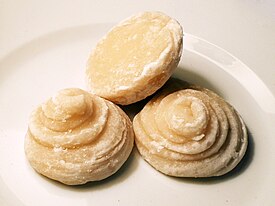Palm sugar


Palm sugar is a
Types
This section needs additional citations for verification. (August 2021) |
The predominant sources of palm sugar are the Palmyra, date, nipa, aren, and coconut palms.[1]
The Palmyra palm (Borassus spp.) is grown in Africa, Asia, and New Guinea. The tree has many uses, such as thatching, hatmaking, timber, a writing material, and in food products. Palm sugar is produced from sap (toddy) from the flowers.
There are two species of date palm that produce palm sugar:
The nipa palm (Nypa fruticans) is native to the coastlines and tropical regions of the Indian and Pacific Oceans. It is the only palm tree that grows in a watery mangrove biome. Only its leaves and flowers are able to grow above water. Palm sugar is made from the sugar-rich sap.
The sugar palm (Arenga pinnata) is native to the coastal and tropical regions of Asia, mainly China, Malaysia, and Indonesia. The sap used to produce palm sugar is known in India as gur and in Indonesia as gula aren.
The coconut palm' (Cocos nucifera) yields coconut palm sugar from the sap of its flowers. It grows in coastal areas of the Indian and Pacific Oceans. Major suppliers are Thailand, Indonesia, and the Philippines.
Production
Palm sugar is produced by boiling collected sap until it thickens.[2][3][4] The boiled sap can be sold as palm syrup. It is sold in bottles or tins and tends to thicken and crystallise over time. The boiled sap can also be solidified and sold as bricks or cakes. It can range in colour from golden brown to dark brown or almost black, like Indonesian gula aren.[5]
Use
Palm sugar is an ingredient in both sweet and savoury dishes used throughout Asia,[6] the Middle East, and North Africa.[7]
Local variants

Palm sugar is known by many names and variants depending on its ingredient, production method, or region. It is known as gula jawa (Javanese sugar) in Indonesia,[8] and gula melaka (Malaccan sugar) in Malaysia. A specific difference in palm sugar naming is seen in Indonesia; if it is made from coconut, it is called as gula jawa or gula merah (red sugar),[9] on the other hand gula aren (aren sugar) refer to palm sugar that specifically made from the sap of aren palm flower buds. Gula jawa has an earthy aroma and deep sweetness with a darker colour closely resembling molasses,[8] while gula aren has paler colour.[9]
Gula melaka is a type of palm sugar made from the sap of flower buds from the coconut palm, or less commonly, other palms.

Gula melaka sago
See also
- Coconut sugar – Sugar produced from the coconut palm
- Date sugar – Sugar extracted from dates
- Jaggery – Unrefined cane sugar
References
- ^ "Palm Sugar in Germany" (PDF). Import Promotion Desk (IPD). CBI, Ministry of Foreign Affairs, The Netherlands. Archived from the original (PDF) on 9 May 2016. Retrieved 6 July 2017.
- ISBN 9780191609497.
- ^ Borin, Khieu (1998). "Sugar palm (Borassus flabellifer): potential feed resource for livestock in small-scale farming systems". FAO World Animal Review. 91.
- ^ Dalibard, Christophe (1999). "Overall view on the tradition of tapping palm trees and prospects for animal production". FAO Livestock Research for Rural Development. 11 (1).
- ^ Eckhardt, Robyn (10 January 2017). "Confessions of a palm sugar addict". Saveur. Retrieved 6 July 2017.
- ^ Kitchen, Leanne (14 July 2015). "10 ways with palm sugar". Special Broadcasting Service (SBS). Australia. Retrieved 6 July 2017.
- ISBN 978-0-313-32956-2. Retrieved 6 July 2017.
- ^ a b "Gula Jawa- Indonesian Palm Sugar or Red Sugar". Asian Fusion. 15 October 2010. Retrieved 13 December 2018.
- ^ a b "Coconut Sugar (Gula Jawa, Gula Merah)". Indonesia Eats. Archived from the original on 15 April 2021. Retrieved 13 December 2018.
- ^ a b Eckhardt, Robyn (10 January 2017). "Confessions of a Palm Sugar Addict". Saveur. Retrieved 22 April 2017.
- ^ ISBN 978-1-4828-5489-3. Retrieved 22 April 2017.
- ISBN 978-981-4435-00-0. Retrieved 22 April 2017.
- ISBN 978-1-909815-47-6. Archived from the originalon 18 August 2020. Retrieved 22 April 2017.
